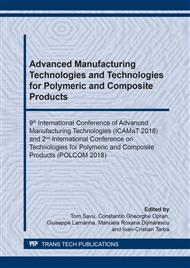[1]
I.D. Marinescu, Handbook of advanced ceramics machining, CRC Press, Taylor & Francis Group, (2007).
Google Scholar
[2]
K.E. Oczoś. Kształtowanie ceramicznych materiałów technicznych, Oficyna Wydawnicza Politechniki Rzeszowskiej/Publishing House Rzeszów University of Technology, (1996).
DOI: 10.18276/sip.2017.48/1-12
Google Scholar
[3]
F. Klocke, Modern approaches for the production of ceramic components, J. Eur. Ceram. Soc. 17 (1997) 457-465.
Google Scholar
[4]
A.N. Samant, N.B. Dahotre, Laser machining of structural ceramics—A review, J. Eur. Ceram. Soc. 29-5 (2009) 969-993.
Google Scholar
[5]
M. N. Farooqui, N.G. Patil, A perspective on shaping of advanced ceramics by electro discharge machining, Procedia Manuf. 20 (2018) 65-72.
DOI: 10.1016/j.promfg.2018.02.009
Google Scholar
[6]
T.B. Thoe, D.K. Aspinwall, M.L.H. Wise, Review on ultrasonic machining, Int. J. Mach. Tool. Manufact. 38 (1998) 239-255.
Google Scholar
[7]
A. Zahedi, T. Tawakoli, J. Akbari, Energy aspects and workpiece surface characteristics in ultrasonic-assisted cylindrical grinding of alumina–zirconia ceramics, Int. J. Mach. Tool. Manufact. 90 (2015) 16-28.
DOI: 10.1016/j.ijmachtools.2014.12.002
Google Scholar
[8]
R. Wdowik, M. Magdziak, J. Porzycki, Measurements of Surface Roughness in Ultrasonic Assisted Grinding of Ceramic Materials, Appl. Mech. Mater. 627 (2014) 191-196.
DOI: 10.4028/www.scientific.net/amm.627.191
Google Scholar
[9]
M. Magdziak, R. Wdowik, Coordinate Measurements of Geometrically Complex Ceramic Parts, Appl. Mech. Mater. 627 (2014) 172-176.
DOI: 10.4028/www.scientific.net/amm.627.172
Google Scholar
[10]
A. Alburayt, W.P. Syam, R. Leach, Lateral scale calibration for focus variation Microscopy, Meas. Sci. Technol. 29 (2018), art. no. 065012.
DOI: 10.1088/1361-6501/aab949
Google Scholar
[11]
R. Danzl, F. Helmli, S. Scherer, Focus Variation - A New Technology for High Resolution Optical 3D Surface Metrology, Proc. of 10th Int. Conf. Slovenian Society for Non-Destructive Testing - Application of Contemporary Non-Destructive Testing in Engineering (2009) 481-491.
DOI: 10.5545/sv-jme.2010.175
Google Scholar
[12]
S. Malkin, T.W. Hwang, Grinding Mechanisms for Ceramics, Annals of the CIRP 45 (1996) 569-580.
DOI: 10.1016/s0007-8506(07)60511-3
Google Scholar
[13]
K. Liu, X.P. Li, S.Y. Liang, The mechanism of ductile chip formation in cutting of brittle materials, Int. J. Adv. Manuf. Technol. 33 (2007) 875-884.
DOI: 10.1007/s00170-006-0531-5
Google Scholar
[14]
ISO 25178-606:2015(en) Geometrical product specification (GPS) — Surface texture: Areal — Part 606: Nominal characteristics of non-contact (focus variation) instruments.
DOI: 10.3403/30251856
Google Scholar
[15]
Alicona Imaging GmbH, IFM Manual, IFM Manual, IFM G4 3.5.1.5 EN April 27, (2011).
Google Scholar
[16]
Information on http://www.alicona.com/focus-variation, accessed 28.08.(2018).
Google Scholar
[17]
R. Wdowik, J. Porzycki, M. Magdziak, Measurements of Surface Texture Parameters After Ultrasonic Assisted and Conventional Grinding of ZrO2 Based Ceramic Material Characterized by Different States of Sintering, Procedia CIRP 62 (2017) 293-298.
DOI: 10.1016/j.procir.2016.06.049
Google Scholar


